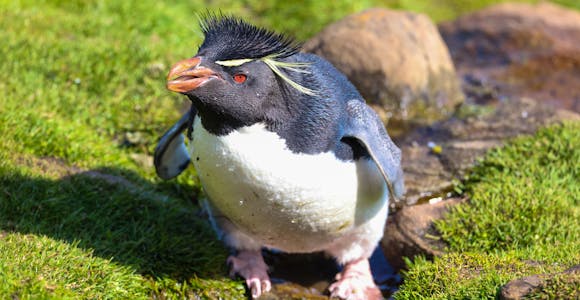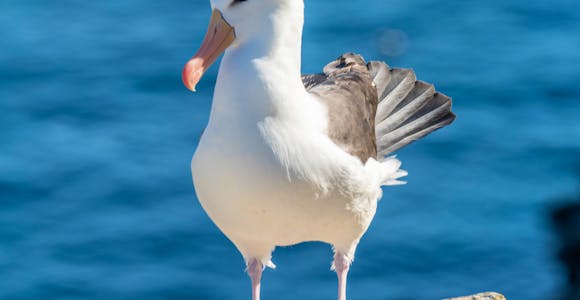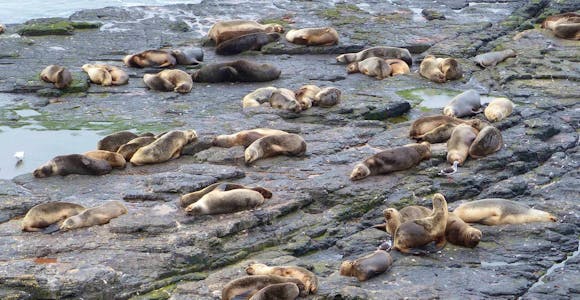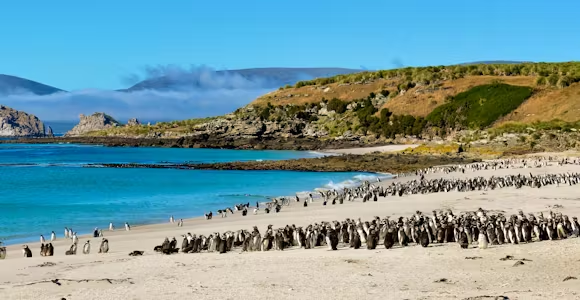
Saunders Island
Saunders Island offers the chance to see four penguin species in one Falklands location, as well as a black-browed albatross colony
Discover More
Rockhopper penguins at Saunders Island
Four species of penguin breed in the Falkland Islands. The most widespread are gentoo penguins: nearly one in three gentoos worldwide are found here. Gentoos make their nests out of pebbles on the beach, or head up the shore into tussac grass to make nests from mud to raise their two chicks. Saunders Island is a good place of gentoo spotting.
Magellanic penguins and rockhopper penguins tend to be favourite among birders as if you're on an Antarctic and South Georgia itinerary, the Falkland Islands are the only place you'll see them. Magellanics (known locally as jackass penguins for their braying call) nest in deep burrows. Carcass Island and Gypsy Cove near Stanley are two of the best places to see them. By contrast, rockhoppers are veritable mountaineers, nesting on the tops of cliffs in places such as Saunders Island.
Finally, many beaches are home to the small numbers of majestic king penguins. It's easy to get distracted by their extremely photogenic nature, but unless you visit the sizeable colony at Volunteer Point, it's worth remembering that you'll see them in quite mind-boggling numbers on South Georgia.

Black-browed albatross on West Point
Any set of islands facing the food-rich Southern Ocean is going to be a hotspot for seabirds, and the Falkland Islands are no exception. The islands are a notable stronghold for the black-browed albatross and a visit to see one of their colonies is a highlight of any trip here. The most accessible is that on West Point, which is home to around 2000 pairs. The birds can be constant companions to expedition cruise ships, which make it a particular treat to see them on their nests. A smaller colony is also often visited on Saunders Island.
Rock shags are commonly seen throughout the islands. The related imperial shag (or blue-eyed shag) is often found nesting with rockhopper penguins, but you'll find a particularly impressive 7000 pair-strong colony on Bleaker Island.
There are plenty of resident petrel and prion species in the Falklands, but they are only seen coming to and from their nests at night so are more easily seen at sea. Instead, you'll see plenty of dolphin gulls, with their grey heads and near scarlet bills and feet.

A male Falkland steamer duck
One endemic species is always high on the list for birders visiting the Falkland Islands: the Falkland steamer duck. This notably chunky flightless bird is often found on the shoreline close to kelp beds in pairs or family group. Known locally as logger ducks, the species is also sometime called the flightless steamer duck to differentiate it from the flying steamer duck also found on the islands.
Upland geese are seen everywhere on the islands and are one of the most common species you'll see. They are a handsome species, with the females wearing a brown head and breasts which are white in the male. If you see an all-white goose it will be a kelp goose – usually seen with its mate, which as black barred plumage. Both kelp geese and upland geese can be found on the shoreline and inland.
Other ducks to look for that can also be found on the South American mainland include the cinnamon teal, speckled teal, red shoveler and Chiloé wigeon. Big Pond on Bleaker Island is a particularly good spot for waterfowl.

Striated caracara
The Falkland Islands are home to a wide variety of songbirds. Of these, the most prized by birdwatchers is the endemic Cobb's wren. Its strongholds are rat-free locations like Carcass Island, where this ground-nesting birds can raise its young without fear of predation. For the same reason you'll also find the tussacbird in places like this.
Several species have local names you won't find in the scientific literature. Listen out for the sweet song of the Falklands pipit, known in the islands as a skylark. Also commonly heard is the long-tailed meadowlark, called a military starling for the red breast worn by the males. Finally, one of the most striking birds you might see is the striated caracara, a hawk known colloquially as a johnny rook.
On the coastline, the magellanic oystercatcher is easily recognisable through its smart black plumage, yellow eyes and red bill (listen out for their piping whistle as well). Where there are sheltered cliffs you might also find rookeries of black-crowned night herons – Gypsy Cove near Stanley is a good place to spot them.

South American sea lions on the jetty at Stanley
The Falkland Islands are home to three species of seal.
South American sea lions are mainly found breeding on the southern side of East Falkland in places like Bleaker Island although itinerant individuals are liable to pop up almost anywhere on the islands. We've even seen them sunning themselves on the jetty at Stanley. Males are instantly identifiable from the thick manes that give the species its name; adult males are around twice the size of females. These sea lions can also be seen when sailing through the Beagle Channel at the start or end of a polar cruise.
South American fur seals are also found in the Falklands – a different but related species to the Antarctic fur seal found in South Georgia, though one equally exploited for its pelt during the 19th century. Look for them around New Island and at Volunteer Point near Stanley.
The largest of the three species is the Southern Elephant Seal. The males haul out on beaches in late October to fight over their harems. Breeding sites often visited by expedition cruise ships include Saunders Island, although often in very small numbers – they're a species you'll see a lot more of in South Georgia.

Commerson's dolphins in the surf at Saunders Island
Although whale watching around the Falkland Islands is not as dramatic as in Antarctica, there are still opportunities to see species you might not see elsewhere.
Two dolphins commonly seen around the islands are Commerson's dolphin and Peale's dolphin. The two species both have very striking black and white markings and can easily be mistaken at a distance. Peale's dolphins are around 2.5 long, while Commerson's are a more pocket sized 1.5m long. You can often see the latter bow-riding cruise ships or playing in the surf at landing sites like Saunders Island.
Orcas (killer whales) can often be found around seal colonies, particularly in the new year when there are plenty of naive pups taking to the water.
Of the great whales, the Falklands Islands can offer a better chance than elsewhere on a polar cruise of seeing sei whales. Berkeley Sound north of Stanley is a noted spot to see them in the summer months; southern right whales are also sometimes spotted here.

Sei whale skeleton on Saunders Island
The early impacts of human settlement in the Falkland Islands were largely negative. The warrah or Falkland Islands wolf, the only native land mammal was hunted to extinction by 1876, by which time the islands' fur seals and sea lion populations had already been driven almost completely to the wall and countless thousands of penguins rendered into barrels of oil. In land, the accidental introduction of rats and mice and deliberate introduction of rabbits all caused severe damage to fragile island ecosystems.
Today the islands remain heavily dependent economically on the fishing industry. Fish and squid catches account for nearly half of all GDP, and the Falkland Islands authorities work hard to maintain sustainable practices. Long line fishing across the Southern Ocean remains a large problem beyond the reach of territorial waters and kills tens of thousands of albatrosses annually. Around 70% of the global population of black-browed albatrosses nest here, and while they appear locally abundant their numbers are crashing to the point where the species is now regarded as being severely threatened – along with the majority of other albatrosses worldwide.
The discovery of oil and gas fields in Falkland Island waters has offered the promise of an economic boom. Many observers hold severe concerns for the fragile ocean ecosystem around the islands should offshore extraction and onshore storage and transfer facilities be developed.
Price Match Promise - We’ll match any price you find elsewhere for the same trip

Saunders Island offers the chance to see four penguin species in one Falklands location, as well as a black-browed albatross colony
Discover More
West Point Island is home to a large cliffside colony of black-browed albatross at the end of a hillside hike, which makes it a popular call for expedition cruise ships.
Discover More
The narrow curved line of Bleaker Island is a great place for birdwatching, with three species of penguin, an enormous imperial shag colony and plenty of waterfowl.
Discover More
The white sandy beaches of Carcass Island are a popular draw for expedition cruise ships, with visitors coming here for the colonies of magellanic and gentoo penguins.
Discover MoreWe'll spend some time listening to your aspirations, then discuss the kind of experience that might suit you.
Next we'll discuss the options, shortlist the best trips for you and present you our impartial recommendations.
We'll place a 24 hour hold on your preferred option - without obligation - whilst we talk through the details.